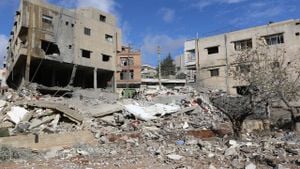This August, NASA and Boeing face significant challenges as astronauts Barry "Butch" Wilmore and Sunita Williams find themselves stranded aboard the International Space Station (ISS) for much longer than planned. What was supposed to be just over eight days of system checks has morphed unexpectedly, pushing their stay to potentially several months due to unforeseen technical issues.
The trouble began during the spacecraft's approach to the ISS, when five of the Starliner's thrusters malfunctioned, resulting in gas leaks and triggering alarms about the mission's viability. Now, NASA and Boeing are on high alert, scrambling to assess the Starliner’s performance and implement troubleshooting measures.
Initially, drastic contingency plans were laid out, considering alternatives like using SpaceX's Crew Dragon for their return if Starliner proved unsafe. This situation has raised serious questions about the spacecraft's dependability and the reliability of Boeing’s systems.
Throughout August, anxiety grew as concerns over the Starliner’s battery life took center stage, with the batteries expected to last only about 45 days when charged on the ISS. The astronauts’ options for remaining functional during this period are increasingly limited.
Ken Bowersox, associate administrator at NASA, emphasized the importance of prompt decision-making as time passes and pressures mount. Officials are racing against the clock to gather necessary data to assure the astronauts' safe return to Earth.
Adding to the tension, the unresolved thruster malfunctions pose risks for undocking, as failing thrusters could lead to uncontrolled drifting away from the ISS. Jonathan McDowell, well-regarded astronomer, warned about the dire consequences should they return with undisclosed mechanical failures.
With their mission pivoting from checks to maintenance and science experiments, both Wilmore and Williams are adapting to prolonged confinement aboard the ISS. This extended stay represents not just physical challenges but psychological ones as they cope with the distance from family and familiar routines.
NASA’s historical context, which includes the tragic Challenger and Columbia missions, has incited heightened levels of caution for the current crew. The agency is now instituting new safety protocols, gleaned from past experiences, to prioritize crew well-being.
Despite initial hopes for external inspections of the faulty hardware, spacewalks have been ruled out to mitigate additional risks. Rather, the focus is anchored on resolving the core operational shortcomings without endangering the astronauts.
Time is running short; NASA prepares for thorough data analysis to determine if the Starliner, under existing circumstances, can safely carry the astronauts home or if alternative measures need to be taken. This predicament not only casts doubt on the immediate mission but raises broader concerns around the viability of Boeing’s future endeavors within crewed space exploration.
Criticism has intensified around Boeing’s reputation, especially following troubles with its 737 MAX model. These fresh hurdles with the Starliner only exacerbate perceptions surrounding the company's capacity for high-stakes space missions.
The air of uncertainty surrounding Wilmore and Williams' fates has sparked worry among their families, who await positive developments with bated breath as August rolls to its close. The public too watches closely, filled with hope but mingled with anxiety for the duo's safe return.
This entire scenario epitomizes the complex and sometimes perilous evolution of aerospace technology. NASA and Boeing must navigate this fraught period carefully, addressing each issue as they weigh the outcomes of their partnership moving forward.
All eyes now remain on the astronauts, focusing on both their personal safety and the broader ramifications for upcoming space missions. Will the lessons from this episode fortify their next steps, or will the lingering issues rend greater doubts about future missions?
The astronauts are left to wonder how much longer their unexpected extension aboard the ISS will linger. Meanwhile, they continue their duties, hoping for good news about their eventual return, and the world waits with them, trailing each development closely.
With each passing day, the pressure builds as NASA and Boeing engage in deep introspection and reconsideration of their approach to human spaceflight. This moment encapsulates the delicate balance between ambition and caution, as both organizations endeavor to maintain their lofty goals amid stringent precautions.
Whether they will emerge empowered from this experience or ensnared by it remains to be seen as the story evolves.
Back on Earth, the support from family members and the broader community underlines the emotional impact of this prolonged separation. Life continues to move on, awaiting the resolution of this extraordinary chapter.
Looking above at the stars, the astronauts can only hope the technologies they've trusted can still render them safe when it's time to return home; their incredible resolve has already been put to the test against unforeseen delays.



